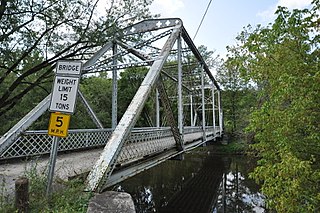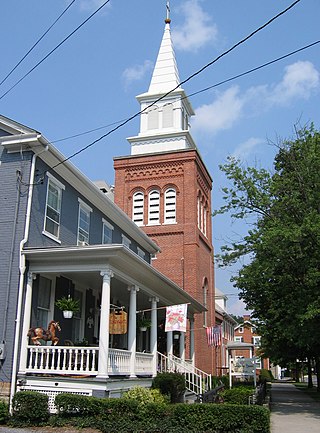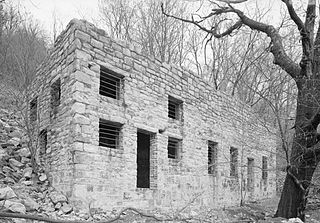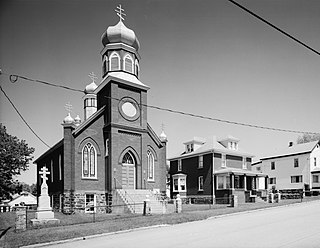
The Allegheny Portage Railroad was the first railroad constructed through the Allegheny Mountains in central Pennsylvania. It operated from 1834 to 1854 as the first transportation infrastructure through the gaps of the Allegheny that connected the midwest to the eastern seaboard across the barrier range of the Allegheny Front. Approximately 36 miles (58 km) long overall, both ends connected to the Pennsylvania Canal, and the system was primarily used as a portage railway, hauling river boats and barges over the divide between the Ohio and the Susquehanna Rivers. Today, the remains of the railroad are preserved within the Allegheny Portage Railroad National Historic Site operated by the National Park Service.

The Allegheny National Forest is a National Forest in Northwestern Pennsylvania, about 100 miles northeast of Pittsburgh. The forest covers 513,175 acres of land. Within the forest is Kinzua Dam, which impounds the Allegheny River to form Allegheny Reservoir. The administrative headquarters for the Allegheny National Forest is in Warren. The Allegheny National Forest has two ranger stations, one in Marienville, Forest County, and the other in Bradford, McKean County.

West Overton is located approximately 40 miles (64 km) southeast of Pittsburgh, in East Huntingdon Township, Westmoreland County, Pennsylvania, United States. It is on PA 819 between the towns of Mount Pleasant and Scottdale. Its latitude is 40.117N and its longitude is -79.564W.

The Allegheny Furnace is an historic iron furnace, which is located in Altoona, Blair County, Pennsylvania, USA.

Birmingham Bridge, also known as Huntingdon County Bridge No. 15 and Blair County Bridge No. 48, is a historic Pratt truss bridge spanning the Little Juniata River and located at Tyrone Township, Blair County and Warriors Mark Township, Huntingdon County, Pennsylvania. It was built by the Pennsylvania Bridge Co. in 1898. It measures 137 ft (42 m) in length and has a 14.7-foot-wide (4.5 m) bridge deck. It is the only means of access to two dwellings on the Blair County side of the river.

Downtown Altoona Historic District is a national historic district located at Altoona, Blair County, Pennsylvania. The district includes 240 contributing buildings in the central business district and surrounding residential areas of Altoona. The buildings were primarily built after about 1860 and include residential, civic, social, and religious buildings. Although it does not encompass the entire downtown, it is for the most part the most urban part of Altoona's downtown district. Notable buildings include the Cathedral of the Blessed Sacrament (1920s), First Methodist Episcopal Church, First Presbyterian Church, First Evangelical Lutheran Church (1896-1897), U.S. Post Office (1931-1933), Fraternal Order of Eagles Building (demolished), Altoona City Hall, Casanave Building (1890s), Hutchison Block, McCrory's Department Store (1937), and Aaron-Penn Furniture Building. Located in the district are the separately listed Central Trust Company Buildings, Mishler Theatre, and Penn Alto Hotel.

Etna Furnace, also known as Mount Etna Furnace, Aetna Furnace, and Aetna Iron Works, is a historic iron furnace complex and national historic district located at Catharine Township, Blair County, Pennsylvania. The district includes five contributing buildings, six contributing sites, and two contributing structures. It encompasses a community developed around an iron furnace starting in 1805. Included in the district is the four-sided stone furnace (1808), gristmill site, canal locks, site of lock keeper's house, aqueduct, two small houses, the ruins of a charcoal house (1808), the foundation of a tally house, a blacksmith shop, bank barn, foundation of a boarding house, three family tenant house, two iron master' mansions, a store and paymaster's office, Methodist / Episcopal Church (1860), and cemetery with graves dating between 1832 and 1859.

Everett Historic District is a national historic district located at Everett, Pennsylvania. The district includes 300 contributing buildings and 1 contributing object in the central business district and surrounding residential area of Everett. The buildings date between about 1830 and 1952, and include notable examples of Gothic Revival and Federal style architecture. Notable non-residential buildings include the U.S. Post Office (1938), Everett Free Library, Zion Lutheran Church, Grace Brethren Church, Barndollar Methodist Church (1860), Everett Hardware Company Building, foundry on North Juniata Street (1874), and Everett Manufacturing Company (1920-1955).

Huntingdon Furnace is a national historic district and historic iron furnace and associated buildings located at Franklin Township in Huntingdon County, Pennsylvania. It consists of seven contributing buildings and one contributing structure. They are the iron furnace, office building, the ironmaster's mansion, log worker's house, a residence, the farm manager's residence, the grist mill and the miller's house. The iron furnace was moved to this site in 1805, from its original site one mile upstream. It measures 30 feet square by 30 feet high. The ironmaster's mansion was built in 1851, and is a 2 1/2-story, "L"-shaped frame dwelling. The grist mill dates to 1808, and is a 3 1/2-story, rubble stone building measuring 50 feet by 45 feet. The furnace was in operation from 1796, until it ceased operations in the 1880s.

The Harbison-Walker Refractories Company is a national historic district and historic refractory brick manufacturing complex which is located in Mount Union in Huntingdon County, Pennsylvania. It originated as the Star Firebrick Company on March 7, 1865, with Articles of Association by a group of Pittsburgh and Allegheny residents.

Mount Union Historic District is a national historic district located at Mount Union in Huntingdon County, Pennsylvania. The district includes 58 contributing buildings, 3 contributing sites, and 1 contributing structure in the central business district and surrounding residential areas of Mount Union. Notable buildings include the Federal-style John Shaver House (1818), Shapiro Theater (1915), T.A. Appleby Store and House, Kenmar Hotel, Penn Central National Bank (1916), Peduzzi's and the Weller Building (1913-1914), Pennsylvania Railroad Freight Depot (1914), St. Luke's Evangelical Lutheran Church (1904-1905), First United Methodist Church (1925-1926), St. Catherine of Siena Roman Catholic Church (1912-1913), Mount Union Elementary School (1923-1924), and U.S. Post Office (1936). The contributing sites include the I.O.O.F. community cemetery, founded in 1872, and the former Victoria Park. Located in the district and listed separately is the Harbison-Walker Refractories Company complex.

The Saltsburg Historic District is a national historic district that is located in Saltsburg in Indiana County, Pennsylvania.

Colver Historic District is a national historic district located at Barr Township and Cambria Township in Cambria County, Pennsylvania. The district includes 336 contributing buildings, 5 contributing sites, and 3 contributing structures. The district consists of residential areas, coal mining resources, Cambria and Indiana Railroad shop buildings, and a dairy farm associated with the Ebensburg Coal Company's mine and developed between 1911 and 1943. Notable buildings include a variety of brick and frame workers' housing, the Ebensburg Coal Company office building (1914), stone company store (1912), Colver Amusement Company (1912), Colver Hotel (1912), Colver Presbyterian Church (1915), public school (1927), hospital (1914), Roundhouse No. 1 (1918), Roundhouse No. 2 (1920), and main power building (1911).

The Revloc Historic District is a national historic district located at Cambria Township in Cambria County, Pennsylvania.

Berwind-White Mine 40 Historic District is a national historic district located at Richland Township and Scalp Level in Cambria County, Pennsylvania. The district includes 121 contributing buildings, 2 contributing sites, and 4 contributing structures. The district consists of a mine site and patch community associated with the Berwind-White Coal Mining Company's Eureka Mine No. 40, and developed between 1905 and the 1941. Notable buildings include over 100 two-story, frame miners' double housing, power house, drift openings, cleaning plant, motor barn, fan house, sand tank, railroad repair car shop, and wash house.

Downtown Johnstown Historic District is a national historic district located at Johnstown in Cambria County, Pennsylvania. The district includes 109 contributing buildings, 4 contributing sites, and 1 contributing structure in the central business district and surrounding residential areas of Johnstown. The district includes some buildings dated before the Johnstown Flood, but the majority date from 1890 to 1930. Notable buildings include the Alma Hall (1884), Bantley Building (1888), Stenger Dry Goods Store (1883), Widmann Building (1892), Cambria Iron Office Building, St. Vincent DePaul Building, Swank Building (1907), Glosser Brothers Department Store (1905), Johnstown City Hall (1900), former U.S. Post Office (1912), State Theater (1926), U.S. Post Office (1938), Franklin Street United Methodist Church (1869), St. John Gualbert Cathedral (1896), First United Methodist Church (1911), Elks Building (1903), and Moose Building (1917). Located in the district and listed separately are the Cambria Public Library Building, G.A.R. Hall, and Nathan's Department Store.

Boswell Historic District is a national historic district located at Boswell in Somerset County, Pennsylvania. The district includes 90 contributing buildings and 1 contributing site. It encompasses an area developed by the Merchant's Mining Company of Baltimore, Maryland starting in 1901. It includes the remaining extant mine resources and the archaeological remains of the mine. They consist of utilitarian industrial buildings, four types of vernacular housing, and a variety of commercial, social, and institutional buildings. Notable buildings include the First National Bank of Boswell (1919), Merchant's Coal Company office (1901), St. Stanislaus Roman Catholic Church (1918), and Sts. Peter and Paul Russian Orthodox Church (1918).

Cairnbrook Historic District is a national historic district located at Shade Township in Somerset County, Pennsylvania. The district includes 132 contributing buildings and 8 contributing structures. It encompasses an area developed by the Loyalhanna Coal and Coke Company of Philadelphia, Pennsylvania between 1912 and 1920. It includes the remaining extant mine resources and the archaeological remains of the mine. They consist of workers' housing, a variety of commercial and social buildings, and a modern draft entry mine with accompanying extractive buildings and structures. Notable buildings include the motor barn, supply house, electric substation, and Loyalhanna Coal and Coke Company Office (1914). The mine operated until 1958.

Delaware, Lackawanna and Western Railroad Yard-Dickson Manufacturing Co. Site is a national historic district located in Scranton, Lackawanna County, Pennsylvania. It encompasses the Steamtown National Historic Site and Scranton Army Ammunition Plant and includes 16 contributing buildings, four contributing sites, and five contributing structures. The yard includes buildings and structures related to the yard's expansion in 1899-1939, and its usage as steam locomotive maintenance complex. The Dickson Manufacturing Company built steam locomotives, and the site of its works are included in this district.

The New Kensington Production Works Historic District, also known as the New Kensington Works and Arnold Works, is a national historic district that is located in New Kensington, Westmoreland County, Pennsylvania.
























